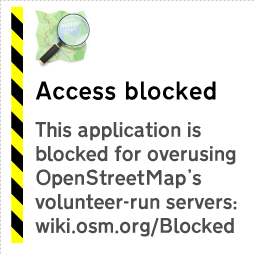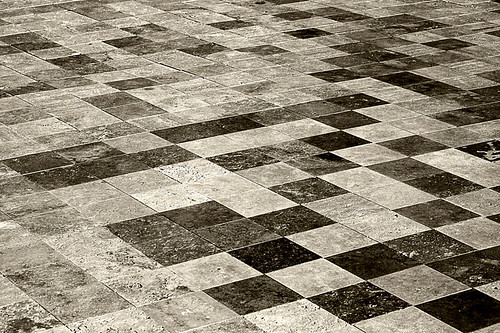We’ve had to block some uses of the OpenStreetMap Foundation tile servers. This article describes what is happening and why. This article also describes how you can adapt if you are affected.
We’re really proud of the increased popularity of OpenStreetMap. We’ve seen seven-plus years of project growth in every measurable area. As the project has grown we’ve learned and adapted in many ways. The use of our tile server has grown faster than every other aspect of the project. One way that we are adapting now, is by restricting how our map tiles may be used.
You’ll still be able to use our tiles in creative and interesting ways but the volume of use will be limited. We need to limit access to our tile server to only those users who don’t overburden our resources.
Those users who make large demands on our tile server will be slowed down by our throttling mechanism. This throttling mechanism is rarely triggered by mappers.

Problematic applications may show this image instead of a map.
Those applications which make exceptional demands in aggregate from their users will be blocked. The tile usage policy is on the OSM wiki.
So what can you do about this? How can you get the wonderful OpenStreetMap tiles for your mobile device?
- You can run your own tile server and serve tiles for yourself or your users.
- You can use an application from a developer that provides a tile server for you.
- You can use tiles created from OSM data, provided by a server that permits bulk downloading.
- You can buy tiles from a commercial provider.
You’ll find more advice about potential tile source alternatives on the wiki.
Read on if you would like to know more about the history of the OpenStreetMap tile server.
OSM tile server background
We started creating rendered images of our map data as a way to encourage our data contributors. Mappers enjoy seeing the results of their surveys on the OpenStreetMap web site, and they can be inspired to map in their neighbourhood the things they see other mappers surveying in other places. Mappers loved the tile server when it first appeared. Potential users often looked at the map in 2006 and said, “Hey, why is there a huge blank spot where my town should be?” Some of those potential users became the long-time contributors that we all know and love.
As more contributors mapped more neighbourhoods, more blank spots started to fill in. More potential users became actual users, and OpenStreetMap tiles started to appear in more places. The tile server became even more popular when rapid updates were enabled. Rather than updating the map every week, parts of the map could update as contributors added data. If you remember the weekly updates you also remember that funny tingle you had the first time you mapped something and it appeared on the map immediately; it seemed like magic, didn’t it?
The OpenStreetMap Foundation has had a tile usage policy for some time. From September 2008 it has been explicitly stated that bulk downloading of tiles was discouraged. OpenStreetMap kept growing. More people came to understand the awesomeness of OSM tiles.
Also in 2008, the Ordnance Survey started serving map tiles to users through their OS Openspace program. In July of 2011, Ordnance Survey served their one billionth tile to a user.
OpenStreetMap serves a Billion tiles every eleven days.
So we know a thing or two about providing awesome maps to users. We do it all with the crowd-sourced data from our contributors around the world, the volunteered time of our sysadmins who keep our servers running, and the generous donations of servers and bandwidth and funds.
We’ve had to become more restrictive of the use of our tile server over time. We’ve limited how many tiles you can consume in a period of time. These restrictions only affected the most-demanding of tile consumers. The everyday mapper never ran into a problem getting tiles to add data to OSM. That allowed the growing number of users to continue to have access to OpenStreetMap tiles without our resources being monopolized by one or two bad actors.
More and more mobile applications started using OpenStreetMap tiles. Many of them included a bulk downloading method so that tiles could be saved on the device at home, rather than downloading tiles at a punitive data rate. That bulk-downloading has always been problematic for OpenStreetMap because a single user will consume hundreds of times the resources of an average user. There are so many applications using OSM tiles, with so many users making unreasonable demands on our resources that it is affecting the quality of service for the average user. And that’s not fair.
So we’ve started blocking the applications that are causing us the most trouble, in addition to blocking users with problematic specific behaviours. We regret it, in a way. After all, we map because we want people to be able to use our data. But our resources have to be used in a way that everybody can share. We can’t have a small number of people consuming all of our resources.
So that’s why some people have started to see the “prohibited” tiles on their maps. Overuse. Or mobile applications that are causing overuse by a group.
This post is also available in: French



to get some impressions on how our server load is distributed you might check out my little visualisation
http://www.openstreetmap.org/user/!i!/diary/15190
Hi. How can I buy data download quotas (or similar) and still financially support the OSM.org project as much as possible? Can I buy from osm.org directly somehow?
Hi Jimmy,
Buying a download quota from a tile vendor, and supporting OSM would be two separate transactions. You can support OSM by mapping your neighbourhood, improving our software, hosting local OSM meetings and many other ways. Also, financial donations can be made through our donate page.
Ok. That’s good enough for now.
What’s OSM’s business model? Only donations? Or are there other business models that proportionally increase OSM’s income along with increases in tile usage and downloads?
I’m just imagining that OSM.org will only very slowly improve as a service if their income is purely based on the donations from private individuals.
I would be happy to pay OSM for tiles because I know the money will result in service improvements. I’m not equally happy paying the other vendors since I’m not really sure how that will affect service quality. Of course I can just donate, but I’d rather like to know if downloading Denmark at the highest resolution really should cost $5 and the pay just that…
Thing is, I not sure there are enough people who would donate because “OSM is a good idea”, which is the incentive behind donating money to any good cause at all.
Pingback: OpenStreetMap / Несколько интересных новостей OpenStreetMap — 9 | Мечты, планы и идеи